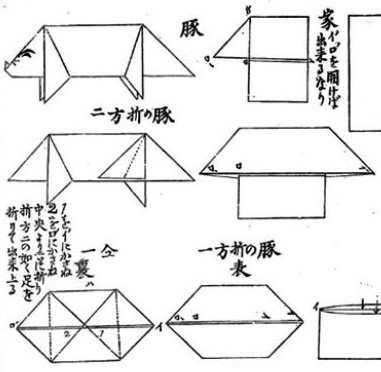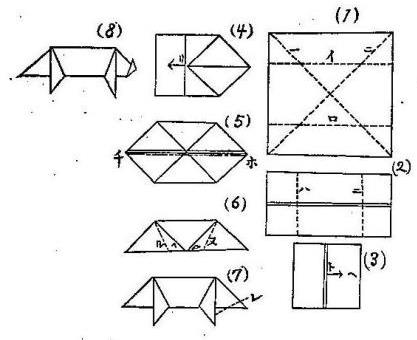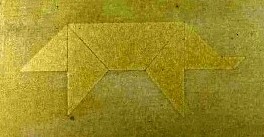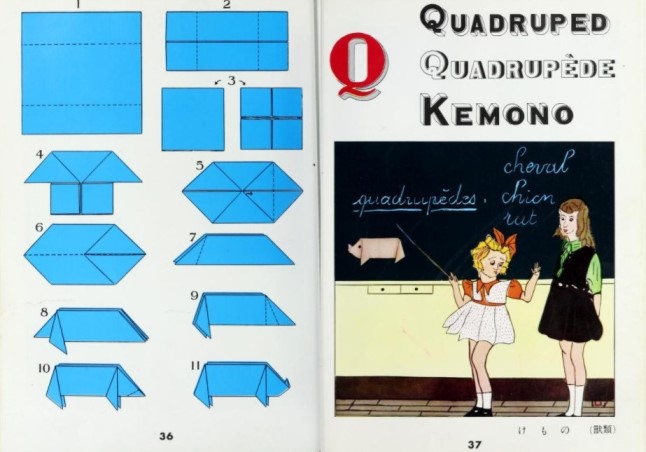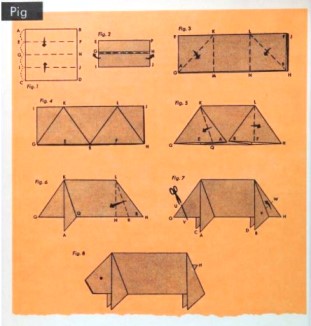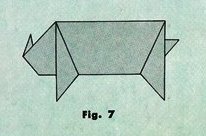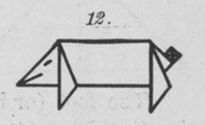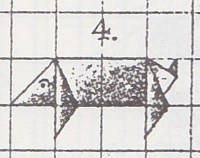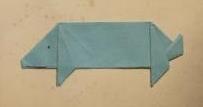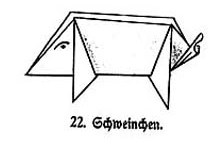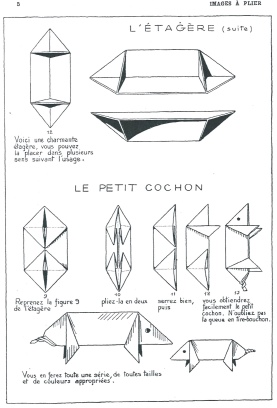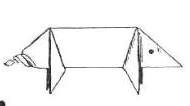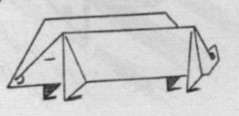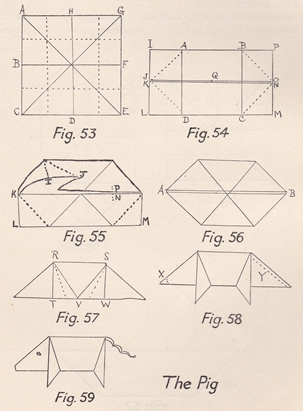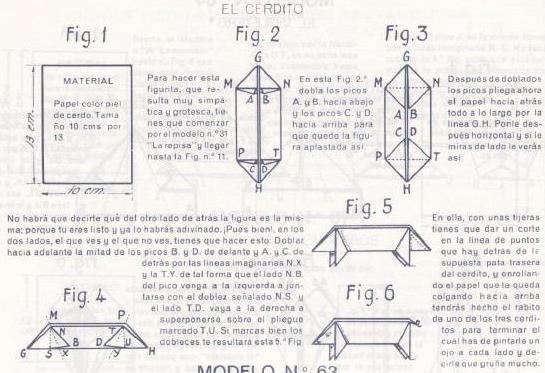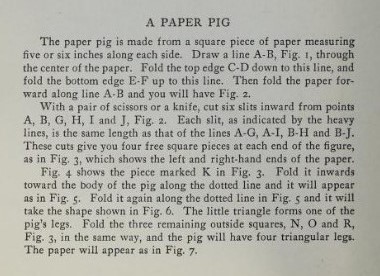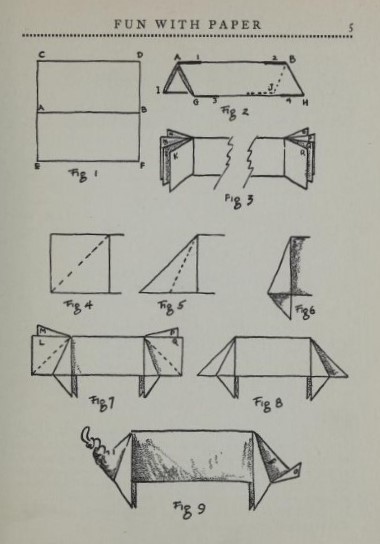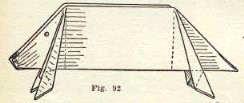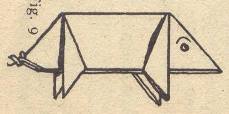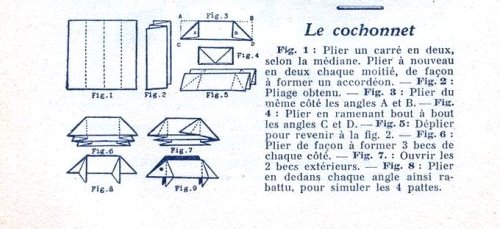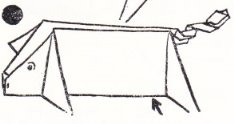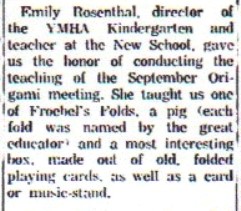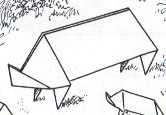| The Public Paperfolding History Project
Last updated 27/8/2025 x |
|||||||
| The Pig | |||||||
| This
page is being used to collect information about the
history of the origami design known as The Pig. Please
contact me if you know any of this information is
incorrect or if you have any other information that
should be added. Thank you. It is possible that this design was the original invention of August Koehler. ********** In Japan (and in publications by Japanese authors) In his article 'History of Origami in the East and the West before Interfusion', published in 'Origami 5: Fifth International Meeting of Origami, Science, Mathematics and Education' in 2011, Koshiro Hatori asserts that, ''Many of the European origami models contained in Krause-Boelte's book (ie 'The Kindergarten Guide') are not included in contemporary Japanese records. The pig, house, sofa (also known as piano or organ), balloon (waterbomb), arrow (paper plane), salt cellar (cootie catcher), bird (pajarita or cocotte) and windmill ... were all born in Europe and imported into Japan along with the kindergarten system.' ********** 1905 As far as I know the earliest publication of the Pig in Japan is in 'Shukouka Kyohon : Liron Jishuu Souga Setsumei' by Kikujiro Kiuchi, Rokushiro Uehara and Hideyoshi Okayama, which was published by Shigebei Takase in Chiba in 1905.
********** The design also appears: 1908 In 'Origami zusetsu' (Illustrated Origami) by Sano Shozo, which was published in Tokyo in 1908.
********** 1931 As 'Pig' in 'Origami (Part 1)' by Isao Honda, which was first published in 1931.
********** 1935 In 'Origami Moyo, Book Two' by Kawarazaki Kodo, which was published in Japan in 1935, contains a print showing the Pig.
********** 1944 In 'Origami Shuko' by Isao Honda, which was published in 1944.
********** 1951 As 'Pig' in 'Origami to Kirinuki' by Saburo Ueda, which was published by Kokkado in Tokyo, most probably in 1951.
********** In 'Origami: Folding Paper for Children' by Claude Sarasas, which was first published by Kodansha in Tokyo in 1951.
********** 1959 With a cut snout, in 'Origami: Book Three' by Florence Sakade, which was published by the Charles E Tuttle Company in Rutland, Vermont and Tokyo in 1959.
********** 1964 In 'My Origami Animals and Fishes' which was published by Crown Publishers Inc, in New York in 1964.
********** In Europe and the Americas 1873 As far as I know this design first appears in the historical record as 'Schweinchen' in 'Die Praxis Des Kindergartens' by August Koehler, which was published by Herman Bohlau in Weimar in 1873.
********** 1882 The design also appears in part two of 'The Kindergarten Guide' by Maria Kraus Boelte and John Kraus, which was probably first published by E. Steiger and Company in New York in 1882.
********** 1895 As 'The Celebrated Pig' in 'Course of Paperfolding' by Eleonore Heerwart, which was published by Charles and Dible in London and Glasgow in 1895.
********** In a sample book of Froebelian paperfolds and papercuts etc made by by Laura B Thompson in 1895.
********** 1896 In part 2 of their book 'The Republic of Childhood', titled 'Froebel's Occupations', which was published by Houghton, Mifflin and Company, of Boston and New York in 1896, Kate Douglas Wiggin and Nora Archibald Smith mention the Pig design and call it 'the crowning glory of the sequence, a star of the purest ray and the first magnitude.'
********** 1897 The Pig also appears in Lois Bates' 'Kindergarten Guide', which was first published by Longmans, Green and Co in London in 1897.
********** The Pig also appears: 1910 As 'Schweinchen' in Part 2 'Das Flechten' of 'Die Frobelschen Beschaftigungen' by Marie Muller-Wunderlich, which was published by Friedrich Brandstetter in Leipzig in 1910.
********** As 'Schweinchen' in 'Allerlei Papierarbeiten' by Hildergard Gierke and Alice Kuczynski, which was published by Drud und Verlag B G Teubner in Leipzig and Berlin in 1910.
********** 1927 As 'Schweinchen' in 'Lustiges Papierfaltbüchlein' by Johanna Huber, which was published by Otto Maier in Ravensburg, Germany, probably in 1927.
********** 1932 As 'Le Petit Cochon' in Booklet 1 of 'Images a Plier', a series of 6 booklets published by Librairie Larousse in Paris in 1932.
********** In Booklet 2 of 'Figuras de Papel', a series of 3 booklets published by B Bauza in Barcelona in 1932.
********** 1933 As 'Cochonnet' in 'Jeux de pliages' by Ferdinand Krch, which was published by Flammarion in Paris in 1933.
********** 1936 As 'Schwein' in 'Faltarbeiten aus Papier 2' (Paperfolding Work) by Georg Netzband, which was published by W Kohlhammer Verlag in Stuttgart and Berlin in 1936. The folding method is explained in the handbook and also in the accompanying educational film F58.
********** In Margaret Campbell's 'Paper Toy Making' published in 1936, although in this case a cut is used to create a wiggly tail.
********** As 'Schweinchen' in 'Allerlei Papierarbeiten' by Hilde Wulff and Carola Babick, which was published in Leipzig and Berlin in 1936.
********** 1939 As 'Cerdo' in 'Trabajo Manual Educativo' by Araminta V Aramburu, which was published by F Crespillo in Buenos Aires in 1939.
********** As 'El Cerdito' in 'El Mundo de Papel' by Dr Nemesio Montero, which was published by G Miranda in Edicions Infancia in Valladolid in 1939
********** An unnecessarily cut version of the Pig design appears in 'Fun with Paper' by Joseph Leeming, which was published by Spencer Press Inc in Chicago in 1939.
********** 1940 As 'Cerdito' in 'El Plegado y Cartonaje en la Escuela Primaria' by Antonio M Luchia and Corina Luciani de Luchia, which was published by Editorial Kapelusz in Buenos Aires in 1940.
********** 1949 In 'Au Pays des Mains Agiles', which was published by Editions Fleurus in Paris in 1949.
********** 1951 As 'Le cochonnet' in 'Occupons nos doigts' by Raymond Richard which was published by Les Editions du Cep Beaujolais in Villefranche-sur-Rhone in 1951.
********** 1956 In 'Paper Magic' by Robert Harbin, which was published by Oldbourne in London in 1956
********** 1961 As 'Schwein' in 'Wir Falten' by Joachim Schönherr and Gerta Schumann, which was published by Rudolf Arnold Verlag in Leipzig in 1961. ********** 1962 'The Origamiian' Vol 2: Issue 4 of Autumn 1962 contains mention of an Emily Rosenthal teaching session at which she taught the Pig:
********** 1963 A design for an unusual version of the Pig appears in the second edition of 'Het Grote Vouwboek' by Aart van Breda, which was published by Uitgeverij van Breda in 1963.
********** |
|||||||
